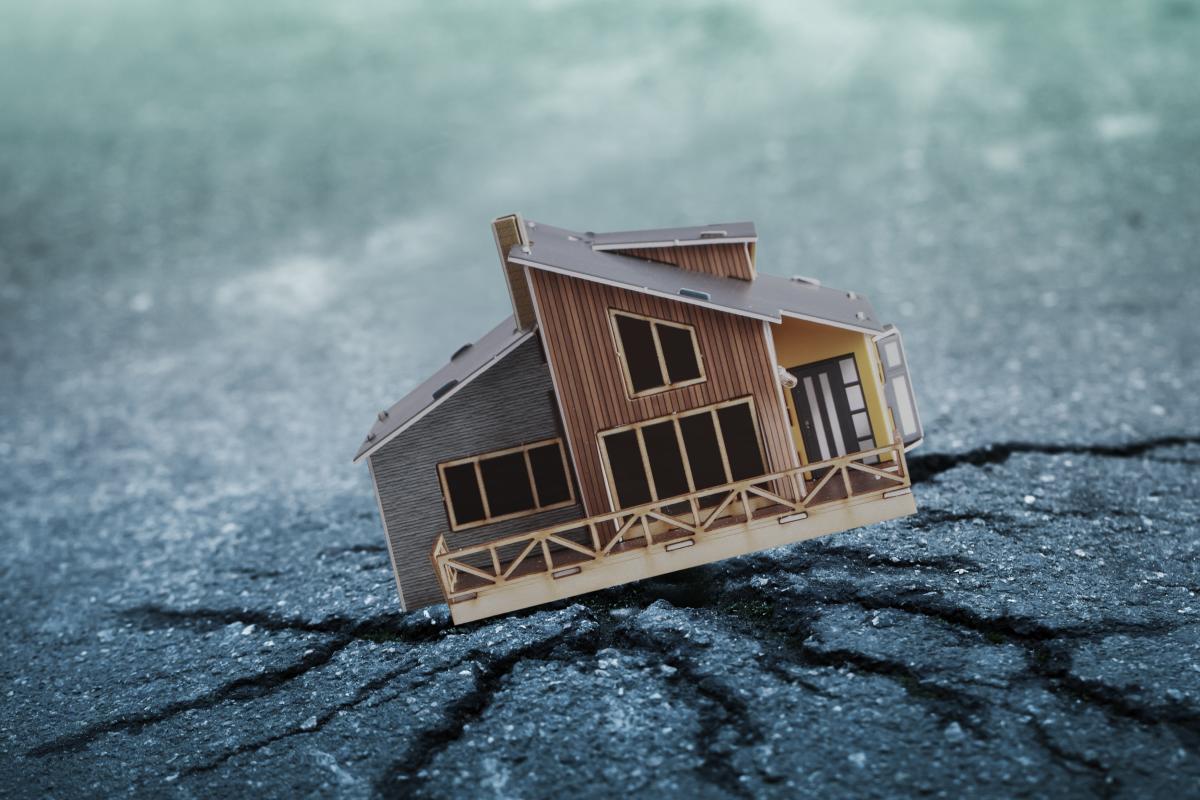How To Prepare For An Earthquake | Make Your Readiness Plan

Every year, more than 500,000 earthquakes shake, rattle, and roll the inhabitants of the United States. While most of these quakes won’t even register for the average person, about 100 will cause damage and a handful have the potential to devastate communities.
If you live near a high-risk earthquake zone or want to prepare for a natural disaster, this guide is the perfect way to kickstart your planning and get your friends and family all on the same page.
What Are Earthquakes?
An earthquake occurs when two tectonic plates located side-by-side suddenly shift or slip along their shared fault line. As these dueling land masses change position, they create and release a burst of energy radiating out from the fault line. This energy burst causes rippling shakes to the ground and everything on it.
Think of an earthquake like the ripples a pond makes when you throw in a stone. Scientists measure those ripples using seismographs, complex instruments with hanging weights to gauge the severity of those ripples. The larger the ripples, the bigger the earthquake. Modern-day seismographs can also measure side-to-side activity, allowing scientists to determine not only the strength of an earthquake but also its distance and duration.
There are two rating systems used to grade earthquakes, but the most widely used is the Richter scale, which translates seismograph readings into an easy-to-understand numerical rating. Each number on the Richter scale represents a tenfold increase in an earthquakes' power compared to the previous number:
2.5 or less on the Richter scale may not even be detectable by the average person,
2.5 to 5.4 earthquakes are often felt and might cause minor damage.
6.0 to 8.0 earthquakes may cause major damage, especially in crowded urban areas, and those rated
8.0 and above can devastate communities near the earthquake’s epicenter.
How Severe of a Problem Are Earthquakes?
Some 20,000 people lose their lives to earthquakes every year. The economic impact is significant, too; financial losses due to earthquakes in the United States are estimated at around $4.4 billion annually. Around 84% of those losses occur along the west coast in California, Oregon, and Washington, but other cities like Charleston, South Carolina, and even Boston and Philadelphia experience economic difficulties due to earthquakes.
There are about half a million detectable earthquakes each year — the average person could detect only 100,000 of those, and about 100 cause significant damage
The world’s deadliest earthquake struck central China in 1556, killing an estimated 830,000 people
The worst modern-day earthquakes include the April 2015 quake in Nepal that killed more than 8,000; a March 11, 2011, earthquake in Japan that left 18,000 people dead or missing; and the devastating disaster that struck Haiti on January 12, 2010, killing an estimated 316,000 people and leaving 1.5 million homeless
Much of the damage associated with earthquakes occurs not because of the quake itself but due to other issues caused by the earthquake, like fires, mudslides, tsunamis, and flooding
Data tracked by the National Earthquake Information Center and the ComCat earthquake catalog indicates that earthquake activity may be increasing in both frequency and intensity
How to Prepare Your Home for an Earthquake
Experts at USGS have put together a seismic hazard map indicating which areas of the United States are most at risk of a seismic event (aka an earthquake). The map is based on models that use historical earthquake patterns and fault-slip rates to determine how likely it is that a given region will experience an earthquake in the next 50 years.
One of the areas with the most potential for danger is the state of California, which has more than 500 active faults. Most Californians live within just 30 miles of an active fault line, increasing the odds they’ll experience multiple earthquakes of varying magnitudes within their lifetime. Another high-risk area is the Circum-Pacific Seismic Belt. Known as the Ring of Fire, this region near the rim of the Pacific Ocean is home to a staggering 81% of the world’s biggest earthquakes.
For people living within these danger zones as well as those residing near smaller fault lines, learning how to prepare their properties for an earthquake could decrease damage and allow for a more positive outcome overall.
To prepare your home, experts recommend following a three-step plan.
1. Secure Your Surroundings
You can’t do much about the existing foundation or structure of your home, but you can secure belongings that could be tossed around during an earthquake. Imagine your home as a snow globe. What would happen to your furniture, decorations and other items if someone decided to give that globe a good shake?
One study of earthquake-related injuries and fatalities found that most of the hospital admissions following the Northridge (Lose Angeles area) earthquake in 1994 were caused by falls or because the patient was hit by a falling object.
Larger furniture-like couches, dining room tables, bookshelves, dressers and beds can be strapped to the wall to avoid those pieces sliding during an earthquake and potentially trapping residents against the wall or other furnishings. Move bookcases away from areas where people might sit or sleep and avoid putting shelves with loose décor like picture frames, vases and collectibles above beds or seating areas. Heavier items should live on lower shelves and nothing large should be situated near escape routes, meaning no bookshelves or oversized benches near the front or back door.
To secure items:
Use straps attached to wall studs to keep items like flat-screen TVs and water heaters upright
Hang mirrors and other wall décor using closed hooks
Tack small objects to shelving with wax or museum putty
Install childproof locks or latches on cabinets and drawers to keep them closed
Anyone living in an earthquake-prone area should check whether their home is up to code. Older buildings may have been grandfathered in, lagging behind current standards in terms of durability and other safety recommendations. You can hire an inspector or contractor to double-check your foundation and walls. If you rent, ask your landlord if the property has been retrofitted to meet current standards and if you can make adjustments to ensure your safety in the event of an earthquake.
Finally, look into purchasing earthquake insurance. Both renters and homeowners are eligible for earthquake-specific policies. Coverage differs from region to region and provider to provider, so shop around and read all the fine print before agreeing to a contract
2. Create a Safety Plan
Knowing what to do and how to protect yourself and your loved ones can help you stay calm and be ready to meet challenges head-on.
Start by identifying safe spots in each room. These spots should be spaces that allow for protection from falling debris. You might want to take cover under a table or desk, for instance. Teach family members, including small children, how to drop, cover and hold on. Resisting the urge to move or change locations is crucial. Ignore old-school advice and pop-culture references that suggest standing in a doorway or running from a building into an open area. Doorways aren’t sturdy enough to provide any protection, and the more you run, the more you’re exposed to debris like broken glass and gravel.
Plan for post-earthquake survival and recovery too.
Have a “go bag” in your home that includes shoes, a flashlight, emergency whistles, and first aid essentials along with items specific to you/your family’s needs such as important medication, hearing aids, or spare eyeglasses
Ensure you have working smoke alarms and a fire extinguisher handy
Learn how to shut off your utilities in the event of gas leaks or water/electricity issues
Take a CPR course and learn how to take care of basic medical needs like applying a tourniquet, splinting broken bones, and treating a concussion
Keep copies of key documents such as personal identification, insurance policies, medical forms, and an inventory of household items in a portable, waterproof container
Communication is key as well:
Talk with your neighbors, identify those with important skills and pool resources
Sign up for local emergency alert systems or related apps
Identify a meetup spot and protocol for family members in case they get separated
Ensure everyone knows important contact numbers rather than relying on smartphone contact lists that may not be accessible in the wake of a disaster
3. Organize Your Disaster Supplies
Earthquakes tend to cause confusion and disorder, which can make it difficult to find the items you need to be comfortable and tackle emergency situations. Buy and organize essential supplies ahead of time and keep them somewhere you can easily access during an earthquake.
Basic supplies recommended by the Red Cross include:
One gallon of drinking water per person, per day
Non-perishable food items
Family-sized first aid kit
Personal medical supplies and medication
Personal hygiene and sanitation items such as hand sanitizer, soap, toothbrush, toothpaste, etc.
Flashlight and extra batteries
Battery-powered or hand-crank radio
A multipurpose utility tools and a can opener
Emergency blanket
Copies of personal documents and important contact information
If you have a baby, elderly family members, pets, or loved ones with special needs, include items specific to them such as baby formula, diapers, or dog food. If room allows, you may want to add to your preparedness bag and include rain gear, N95 or surgical masks, work and/or surgical gloves, duct tape, scissors, blankets or sleeping bags, matches, candles, and items like books that can be used for entertainment.
Some people choose to divide their “go bags” into multiple kits, stowing smaller versions in each family vehicle and in various spots around the home.
How to Survive an Earthquake
Every earthquake is different, not only in terms of magnitude but also in how each person experiences it. The shaking may not seem so bad if you’re in a sturdy building with few lose items around. The same earthquake could devastate a dilapidated building and harm inhabitants who are unaware of safety recommendations. What you did to survive one earthquake may not be enough to meet the challenges of the next.
Maximize your chance of survival and minimize the potential for injury by following expert advice to Drop, Cover and Hold On.
Drop: When an earthquake hits, drop where you are and stay on your hands and knees. This stance keeps you at the ready to crawl to shelter while also providing partial protection against falling debris.
Cover: Use one arm and hand to cover your head and neck. Then, when possible, crawl to a sturdy table or desk or to a stable interior wall and crouch on your hand and knees.
Hold On: Hold on to your shelter with one hand, protecting your head and neck with the other, until the shaking stops.
This simple approach to personal earthquake protection is easy to remember and effective if done correctly, but it doesn’t apply to every situation.
People with disabilities may need to modify Drop, Cover and Hold On — those who use wheelchairs or who can’t physically drop to the floor can shelter in place on a chair, pushing that chair up against a wall away from windows if possible
If you’re in a commercial space like a grocery store, try to shelter under soft items, like a clothing rack, and away from packed shelves
If an earthquake strikes while you’re in bed, stay there, lying face down and holding a pillow over your head and neck until the shaking stops
Apartment dwellers and those in a high-rise office building or similar structure should shelter in place and avoid windows and elevators
People stuck in crowded areas like a festival, movie theater or sports arena should shelter in or next to their seat, assuming the recommended face down/hand and arm over your neck position
If you’re driving, avoid the urge to speed away from danger (you can’t outrun an earthquake) — your safest bet is to pull over away from bridges and other potential hazards, cut the engine, set the parking brake, and stay put until it’s safe to move again
Earthquakes near water can cause tsunamis, which makes it imperative for anyone near a shoreline to immediately seek higher ground, preferably staying on foot and away from traffic
Immediately After the Earthquake
When the shaking from an earthquake stops, that doesn’t necessarily mean the danger has passed. Aftershocks are smaller, lower-intensity earthquakes that follow the main earthquake. This is basically the earth readjusting following a tectonic shift. Aftershocks are most common within the first hour after an earthquake and the risk quickly drops from there. While aftershocks may not be as intense as the original quake, they can be just as dangerous because they’re unpredictable and catch people when they’ve been lulled into a false sense of security.
Still, there are some actions you can take to improve security while taking care of those who have been injured and prevent further damage.
Get to Safety
This might mean working your way out from a situation that has you trapped, such as under debris or inside a building with a blocked exit. If you can move, use your shirt or a spare cloth to cover your mouth, eyes, and nose to prevent breathing in dust. Address injuries as well as you can, then either make your way to safety or stay put and signal for help by knocking on solid surfaces three times, pausing, then knocking again until rescue personnel respond.
Decide Whether To Evacuate
In many cases, the best thing you can do after an earthquake is to shelter in place until order is restored. But in some situations, staying put is far more dangerous than moving. If you’re near a large body of water, you may be in the path of flooding or even a tsunami. Get to higher ground as soon as possible, staying on foot and avoiding congested roadways and bridges that increase risk of injury.
Keep in mind that coastal zones are often considered risky for several days following an earthquake. Don’t return to those areas until officials give you the go-ahead.
If you’re not near water, the only reason to evacuate is if the structure you’re in is damaged or there are other risk factors that make it unsafe to stay put. You may want to relocate from a commercial facility like a storefront to your own home or leave your home to go to a friend or family member’s house. Loss of power isn’t necessarily a good reason to move; power outages are typically widespread, and lack of electricity is a lower risk compared to more hazardous scenarios.
Helping the Injured
First responders may not reach you quickly enough in the aftermath of an earthquake. In the interim, you can use basic first aid skills to stop bleeding, administer CPR and keep those in shock warm until help arrives.
Securing the Area
To prevent further injuries and damage, secure items that could fall during an aftershock and check utilities for high-risk situations that could cause harm. Use a fire extinguisher to put out any small fires before they get out of hand. If you suspect problems with electrical wiring and power lines or smell a gas leak, shut off those utilities using the main gas valve or breaker switch.
While not a top priority, cleaning up spills can prevent slips and falls and keep harmful chemicals away from children and pets.
Stay Alert, Stay In Touch, Stay Informed
Communication is vital. Some traditional methods of communication like mobile phones and the internet may be compromised depending on the severity of the structural damage in surrounding areas. Still, you can use a battery-powered or hand-crank radio to find public service announcements regarding the earthquake, safety stations, and other information. NOAA Weather Radio is a reliable resource as are local emergency alert systems like CalAlerts.org in California.
Reach out to friends and family to let them know you’re okay. Certain social media sites such as Facebook and organizations like the Red Cross set up applications for people to use to register as safe. Keep communication to essential messages only; when cell networks get overloaded, it becomes difficult if not impossible for emergency calls to get through.
On The Road To Recovery
Depending on the magnitude of the earthquake and the damage it’s left behind, recovery could be as simple as a quick cleanup and getting back to your normal routine or as complex as creating a completely new normal from scratch.
If you’ve been displaced, it’s time to figure out how you’ll move forward. First, deal with urgent needs like ensuring your safety, connecting with loved ones, replenishing food and water, refilling medications, and figuring out long-term shelter.
As you gauge the damage in your home, follow this checklist:
Check for gas leaks and faulty electrical wiring, including built-in appliances or lighting that may have been knocked loose
Watch for chemical spills
Check for water leaks and turn off the water main if necessary
Let water run before drinking and avoid consuming water that appears to be dirty or otherwise tainted
Examine the general structure of your house, taking note of any walls that are cracked or learning, weaknesses or openings in the roof, and gaps in the foundation
If you have power, see if the remaining refrigerated and frozen food is usable
Use existing stores to make up a meal list and shop or otherwise make arrangements for food and water if your supplies are low (there should be PSAs announcing community efforts to provide food, shelter, and supplies)
If you cannot stay in your home, gather up basic necessities including your emergency preparedness kit or go bag and make your way to the shelters announced by local authorities. If you're able to carry spare bedding, food and water, a change of clothing, and supplies for your infant and/or pets, do so — those supplies may be limited for the time being while larger rescue and rebuilding efforts fall into place.
On the subject of pets, note that not all shelters will allow them unless they’re trained service animals. You may also be limited in terms of what belongings you can bring in order to make the most of limited space. Leave valuables and larger items at home or in another more secure location.
If you need short- or long-term assistance, know that there are resources available:
The Red Cross is often on scene after a natural disaster conducting search and rescue efforts, providing medical care, serving food and water, distributing supplies, and providing shelter
Disasterassistance.gov includes a clearinghouse of contact information for organizations offering financial assistance for those affected by natural disasters
If the President activates FEMA (the Federal Emergency Management Agency), you may be eligible for the Individuals and Households Program, which helps fund and facilitate everything from home repairs to temporary housing to disaster-proofing in advance of future earthquakes
Preparing for an earthquake can be time-consuming and even scary. Thinking about what might happen during and after a natural disaster isn’t pleasant, but it is necessary if you want to be prepared and minimize the risk for you and your family. Even if you’ve already been through an earthquake, there’s more work to be done. Rework your plan. Fine-tune your emergency kit. Add new medications or jarred food for your toddler to your supplies. Every step you take toward a bigger, better plan is another step toward survival and a brighter future.
Expertise.com StaffAuthor
At Expertise.com, we're passionate about guiding people to find the best in life, whether they're researching how to start a small business, planning a home remodeling project, or discovering a new hobby.
Sources
1. “Earthquake Hazards Program.” National Earthquake Information Center (NEIC) via the U.S. Geological Survey.
2. “ANSS Comprehensive Earthquake Catalog (ComCat) Documentation.” U.S. Geological Survey.
3. “Cool Earthquake Facts.” U.S. Geological Survey.
4. “Deadliest earthquakes of the past decade.” Katharine Lackey, USA Today.




